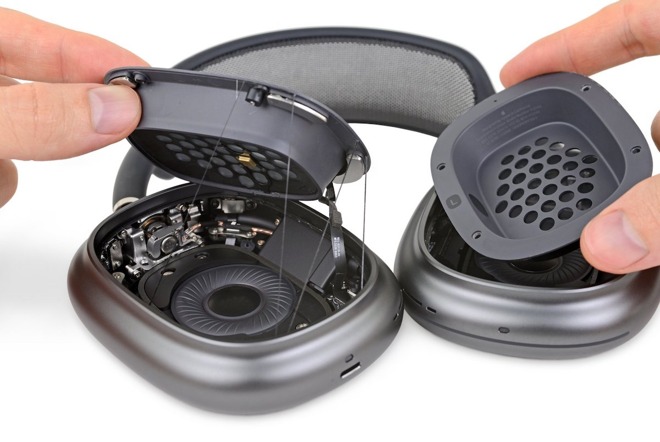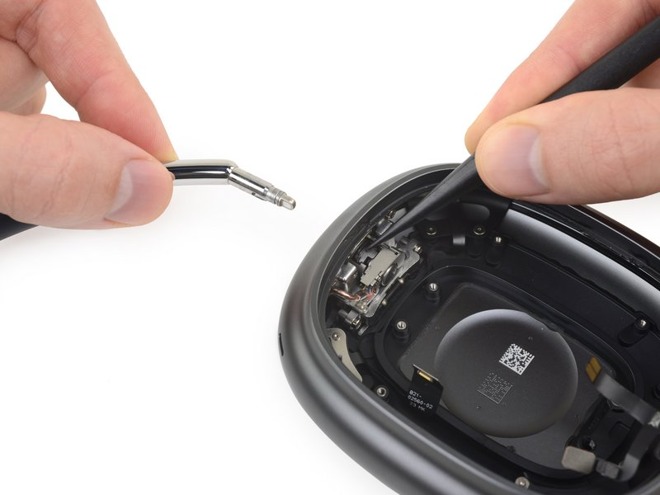AirPods Max 'devastatingly overengineered' but repairable, demonstrates teardown
Repair specialists at iFixit have completed a teardown of AirPods Max, demonstrating Apple's "obsessive craftsmanship" that makes other offerings look "like toys, by comparison."

Credit: Andrew O'Hara, AppleInsider
For example, the headband portion of the AirPods Max appears to be easily removable with a simple SIM ejection tool. As iFixit puts it, "a little poke in just the right place compresses two tiny springs ... freeing the clamp that secures the headband."
That ease of disassembly runs counter to the complexity of some AirPods Pro components. The electromechanical hinge is described by the repair site as "both intricate and overbuilt." It even adds that the engineering and design may justify the steep price of the headphones.

Credit: iFixit
Other components are not as easily disassembled as the headbands, but user repairs are still possible. Getting into the actual ear cup portions of the AirPods Max requires some specialized screwdriver bits and the melting of some adhesive, but tearing it down is still user-achievable.
Although not for the faint of heart, it's possible to access key components like the battery and Lightning port by disassembling the earphones. The latter component is responsible both for charging and listening, since the AirPods Max lacks 3.5mm auxiliary cable compatibility.
The teardown concludes by likening the design of AirPods Max to a mechanical watch. Its components are "intricate," "precision-engineered," and its design is more complicated than other headphones on the market.

Credit: iFixit
However, the AirPods Max is still surprisingly repairable despite the complexity. Some parts, like the easily-removable ear cushions and headband, are even described as "DIY-friendly."
"And after tearing down some of the competition, we're more understanding of that $550 price tag. Sony and Bose both charge less, but internally, the AirPods Max's obsessive craftsmanship makes those other extremely capable devices look like toys by comparison," iFixit writes.
As a result of those service-friendly touches, iFixit has given the AirPods Max a repair score of six. It's the first non-zero score assigned to an AirPods product.

Credit: iFixit
Of course, users should take care before carrying out any repairs -- even if they're easier than expected. It isn't clear at this point if removing the headband, as an example, voids the device's warranty.

Credit: Andrew O'Hara, AppleInsider
For example, the headband portion of the AirPods Max appears to be easily removable with a simple SIM ejection tool. As iFixit puts it, "a little poke in just the right place compresses two tiny springs ... freeing the clamp that secures the headband."
That ease of disassembly runs counter to the complexity of some AirPods Pro components. The electromechanical hinge is described by the repair site as "both intricate and overbuilt." It even adds that the engineering and design may justify the steep price of the headphones.

Credit: iFixit
Other components are not as easily disassembled as the headbands, but user repairs are still possible. Getting into the actual ear cup portions of the AirPods Max requires some specialized screwdriver bits and the melting of some adhesive, but tearing it down is still user-achievable.
Although not for the faint of heart, it's possible to access key components like the battery and Lightning port by disassembling the earphones. The latter component is responsible both for charging and listening, since the AirPods Max lacks 3.5mm auxiliary cable compatibility.
The teardown concludes by likening the design of AirPods Max to a mechanical watch. Its components are "intricate," "precision-engineered," and its design is more complicated than other headphones on the market.

Credit: iFixit
However, the AirPods Max is still surprisingly repairable despite the complexity. Some parts, like the easily-removable ear cushions and headband, are even described as "DIY-friendly."
"And after tearing down some of the competition, we're more understanding of that $550 price tag. Sony and Bose both charge less, but internally, the AirPods Max's obsessive craftsmanship makes those other extremely capable devices look like toys by comparison," iFixit writes.
As a result of those service-friendly touches, iFixit has given the AirPods Max a repair score of six. It's the first non-zero score assigned to an AirPods product.

Credit: iFixit
Of course, users should take care before carrying out any repairs -- even if they're easier than expected. It isn't clear at this point if removing the headband, as an example, voids the device's warranty.

Comments
And what "hot electronics"? It's a pair of headphones, hardly gets any hot.
Some people will complain about anything....
The real question is is the (over) engineering justified and necessary? On one hand one can argue that the AirPods max are better built than other headphones and the price is justified. On the other hand one could say that other 'less engineered' headphones have good sound and the extra design and construction costs of the AirPods Max's are not justified. Like everything with these, it is the eye o the beholder.
I think you both are dialing in to some of the reasons and sounds similar to the original HomePod and it's original MRSP and the lack of adoption.
"Turns out" from actual real-world experience? Do share!
Ventilation of "noise-cancelling" headphones is a difficult catch-22. The headphones need to fully control air movement in order to cancel out external sounds.
I remember someone telling me that the iPod was badly engineered because it could only go to sleep and could not be switched off. However, the iPod never had such a severe battery drain.
It is pure bliss when I put them on and listen to my music, but the battery drain and case are legitimate complains, IMO.
I prefer more expensive, quality items that last a lifetime than cheap junk. I bought a pair of Razor gaming headphones I barely used, and they’re literally disintegrating.
Foam rubber is notorious for breaking down with age. Making the ear pads easily replaceable on on the APM’s was smart.
I think you are confusing well engineered with over engineered. I completely agree with you in that I too would rather spend a bit more on a quality product that will last. (iPhones and Macs are a good example of this.) If the design becomes excessive such that it wastes material and money with little to no benefit then there’s no point. The relatively ‘under engineered’ sony and Bose headsets seem to hold up just fine, which would argue against the theory that APMs are worth the money solely because of their construction.
Determining that a product is under engineered is usually an easy task. Over engineered products aren’t always so easy to detect unless you truly know the full set of intentions of the designer. It’s very common for engineers to include “engineering margins” in their functional designs so their products can survive stressful situations that temporarily exceed the guaranteed application tolerances they advertise to customers. This is a form of over engineering that can pay dividends and build customer loyalty, but only to a certain degree. You don’t want your customers to think you’re simply sandbagging on your specs. Likewise, there are cases where one attribute of a product overwhelms the design decisions. For example, it’s easy to say that a one time use plastic straw that takes 50 years to decay is over engineered, but the fact that the plastic straw does not collapse after 5 minutes of use, like a paper straw might, is what drove the design.
The most egregious cases of over engineering that I’ve encountered, and even been guilty of, involve applying intentional design, i.e., “Design for X” - where X is some quality attribute like modular upgradability or high load tolerance, that ended up being a non factor in the final product. Going to great lengths to accommodate a product quality that is never realized is over engineering. Is it bad design? I guess if you are paying for something that returns less business value than what you anticipated it should, you could say it is bad design. But “over engineered” is a less harsh sounding assessment, and if you learned something from it, it’s not all bad. Besides being intentional, product design is often anticipatory and the rules of the game can change during the development cycle. Engineering choices that made perfect sense when you were targeting a system that was intended for 3000 units may suddenly not make as much sense when the order is cut too 30 units.
As a customer I have much more tolerance for over engineered products than under engineered products, as long as I can live with the excessive costs that are involved, but only to a certain degree.